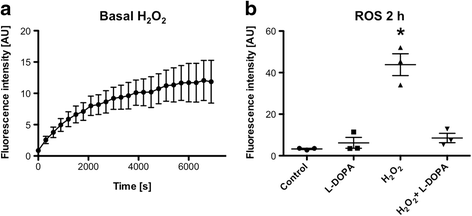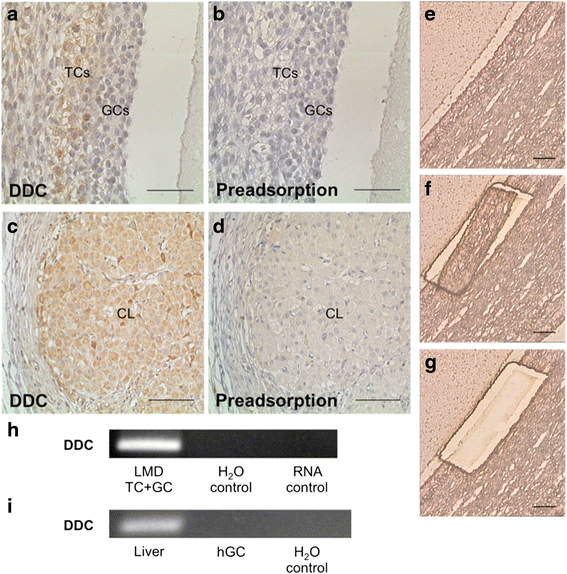L-DOPA in the hu man ovarian follicular fluid acts as an antioxidant factor on granulosa cells
- PMID: 27686972
- PMCID: PMC5043631
- DOI: 10.1186/s13048-016-0269-0
L-DOPA in the hu man ovarian follicular fluid acts as an antioxidant factor on granulosa cells
Abstract
Background: A previous study showed that dopamine (DA), which is contained in follicular fluid (FF) from IVF patients, strongly increased the production of reactive oxygen species (ROS) by cultured human granulosa cells (GCs). ROS, including H2O2, are assumed to play roles in ovarian physiology and pathology. Ovarian DA could be derived from the circulation, ovarian innervation and/or unknown ovarian sources. L-DOPA is the direct precursor of DA in its synthetic pathway. It was not yet described in FF. We examined L-DOPA levels in FF from IVF patients. As it may exert anti-oxidative and ROS-scavenging functions, we studied whether it exerts such actions in human GCs and whether DOPA-decarboxylase (DDC), the enzyme converting L-DOPA to DA, is expressed in the human ovary.
Results: ELISA measurements revealed that human IVF-derived FF contains L-DOPA. In cultured human GCs automated confluence analyses showed that L-DOPA enhanced their survival. This is in contrast to the actions of DA, which reduced cell survival. A dose-dependent mode of action of L-DOPA was identified using a fluorescent ROS indicator. The results showed that it antagonized intracellular ROS accumulation induced by exogenous H2O2. DDC was absent in follicular GCs, but immunohistochemistry identified it in theca cells (TCs) of large follicles in the human ovary. Laser micro-dissection followed by RT-PCR corroborated the expression. DDC was also identified in the steroidogenic cells of the corpus luteum.
Conclusions: L-DOPA in FF is an antioxidant factor and exerts positive influences on GCs. Ovarian DA is derived from L-DOPA and has opposite actions. Exogenous L-DOPA is a standard therapy for Parkinson's disease, and the results raise the possibility that it may be able to exert positive actions as an antioxidant in ovarian conditions, as well.
Keywords: Granulosa cells; L-DOPA; Reactive oxygen species.
Figures




Similar articles
-
Dopamine in human follicular fluid is associated with cellular uptake and metabolism-dependent generation of reactive oxygen species in granulosa cells: implications for physiology and pathology.Hum Reprod. 2014 Mar;29(3):555-67. doi: 10.1093/humrep/det422. Epub 2013 Nov 27. Hum Reprod. 2014. PMID: 24287819
-
Decorin is a part of the ovarian extracellular matrix in primates and may act as a signaling molecule.Hum Reprod. 2012 Nov;27(11):3249-58. doi: 10.1093/humrep/des297. Epub 2012 Aug 11. Hum Reprod. 2012. PMID: 22888166 Free PMC article.
-
Pigment-Epithelium Derived Factor (PEDF) and the human ovary: a role in the generation of ROS in granulosa cells.Life Sci. 2014 Mar 3;97(2):129-36. doi: 10.1016/j.lfs.2013.12.007. Epub 2013 Dec 17. Life Sci. 2014. PMID: 24361362
-
Peculiarities of L: -DOPA treatment of Parkinson's disease.Amino Acids. 2005 Mar;28(2):157-64. doi: 10.1007/s00726-005-0162-4. Epub 2005 Mar 9. Amino Acids. 2005. PMID: 15750845 Review.
-
Transplantation of autologous sympathetic neurons as a potential strategy to restore metabolic functions of the damaged nigrostriatal dopamine nerve terminals in Parkinson's disease.Brain Res Rev. 2006 Sep;52(2):244-56. doi: 10.1016/j.brainresrev.2006.03.001. Epub 2006 Apr 27. Brain Res Rev. 2006. PMID: 16644019 Review.
Cited by
-
Human Luteinized Granulosa Cells-A Cellular Model for the Human Corpus Luteum.Front Endocrinol (Lausanne). 2019 Jul 9;10:452. doi: 10.3389/fendo.2019.00452. eCollection 2019. Front Endocrinol (Lausanne). 2019. PMID: 31338068 Free PMC article. Review.
-
Advanced oxidation protein products from the follicular microenvironment and their role in infertile women with endometriosis.Exp Ther Med. 2018 Jan;15(1):479-486. doi: 10.3892/etm.2017.5390. Epub 2017 Oct 30. Exp Ther Med. 2018. PMID: 29387200 Free PMC article.
-
A Role for H2O2 and TRPM2 in the Induction of Cell Death: Studies in KGN Cells.Antioxidants (Basel). 2019 Oct 29;8(11):518. doi: 10.3390/antiox8110518. Antioxidants (Basel). 2019. PMID: 31671815 Free PMC article.
-
The NADPH oxidase 4 is a major source of hydrogen peroxide in human granulosa-lutein and granulosa tumor cells.Sci Rep. 2019 Mar 5;9(1):3585. doi: 10.1038/s41598-019-40329-8. Sci Rep. 2019. PMID: 30837663 Free PMC article.
-
Dopamine synthesis and dopamine receptor expression are disturbed in recurrent miscarriages.Endocr Connect. 2018 May;7(5):727-738. doi: 10.1530/EC-18-0126. Epub 2018 Apr 23. Endocr Connect. 2018. PMID: 29686031 Free PMC article.
References
-
- Saller S, Kunz L, Berg D, Berg U, Lara H, Urra J, et al. Dopamine in human follicular fluid is associated with cellular uptake and metabolism-dependent generation of reactive oxygen species in granulosa cells: implications for physiology and pathology. Hum Reprod. 2014;29:555–67. doi: 10.1093/humrep/det422. - DOI - PubMed
-
- Saller S, Merz-Lange J, Raffael S, Hecht S, Pavlik R, Thaler C, et al. Norepinephrine, active norepinephrine transporter, and norepinephrine-metabolism are involved in the generation of reactive oxygen species in human ovarian granulosa cells. Endocrinology. 2012;153:1472–83. doi: 10.1210/en.2011-1769. - DOI - PubMed
LinkOut - more resources
Full Text Sources
Other Literature Sources
Research Materials

